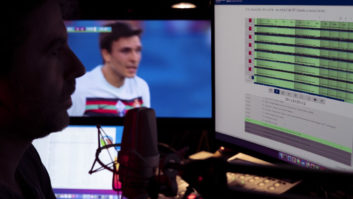Keep It, Pitch It or Part It?
Jul 1, 2013 8:00 AM, By Doug Irwin, CPBE DRB AMD
I’ll admit I’m a pack rat when it comes to keeping various RF items at the transmitter site. The time comes, though, when various items need to be tossed out (or as we say now “e-wasted”). Part of the reason for keeping stuff is its potential value in a pinch, right? Who knows when you might need a whatsit, after all. So let me suggest a compromise: Take a look at the items you have stashed, and see if they have valuable components that might be useful later on, and strip them out. Junk the rest. At least that will save you some space. Let’s take a look at some examples.
I found a very old 950MHz STL transmitter switch controller recently that hadn’t been used in years, plus its complement, the receiver switcher. We no longer use dual analog STL links so this equipment is obsolete. But still, do I want to ditch the best parts? The answer is no! The coaxial relay has lots of residual value. (Have you tried buying one lately?) The receiver power-divider is pretty much an off-the-shelf item but I kept it regardless.

Receiver switcher

Receiver power divider
Speaking of 950MHz power dividers: If you find one at your site, keep it. This is another 950 MHz power divider. In reality it looks like a -3dB hybrid combiner. (Perhaps someone knows that for sure?)

950MHz power divider
Do you know what a cavity resonator is? These are a couple of very small ones (small for 950MHz anyway). Just because you find them sitting around unused at one of your sites doesn’t mean that they won’t be useful one day — at some other site. Hang on to these. At some point you may need a filter in the 950 band (in a pinch).

Cavity resonator
Finally if you happen to see something like the image below lying around, by all means keep it. This is a line-stretcher, or more commonly known as a trombone. It’s a piece of transmission line (kind of like a mini hardline) and its physical (and hence electrical length) can be changed.

Line stretcher
Still more on filters
Speaking of electric length, a few months back I described how to use a piece of transmission line as a notch filter. I want to look at a very practical way to cut these to length. Refer to this formula: 2952/f(MHz) = 1/4 wavelength in inches.
The next step is to determine the velocity factor of the coax you plan to use; multiply that by the previous result. For example, using 100.3MHz, and a transmission line with a velocity factor of 0.66, you come up with the result of 19.43″. In practice you would T this filter off of your transmission line. How long is the center conductor pin inside the T connector? And how close do you really need to be to 19.43″? Here’s a simple solution. Get the coax piece, cut it several inches longer than your calculations show is necessary. Next, you’ll need a means by which you can measure the attenuation of this filter. Put a receiver of some sort on the frequency you want to attenuate, on the end of the transmission line coming in from an antenna or from some other source (like an RF signal generator). First, leave the filter section off the T connector. Make note of the receive level as a beginning reference point. Then, connect the ‘filter’ section of coax to the T connector. Re-measure your signal strength on the receiver. Snip a half inch off the end of the line. Re-measure the attenuation. Now you may want to move the RF source and the receiver down in frequency to find where the filter is currently tuned — great. That’s like a reality check. Move up in frequency, take another snip off the line, remeasure. Clearly there may be quite a few iterations, but as you get closer to where your calculations show you ought to be, take a shorter and shorter piece off. Put a piece of heat shrink on the end of the filter line when you are done.
In practice I have found that you can achieve 30dB of attenuation with this sort of filter, but it has a very broad Q; it would be appropriate in notching out a local transmitter that is out of band, but still de-sensing your local receiver (as an example).
Irwin is RF engineer/project manager for Clear Channel Los Angeles. Contact him at [email protected].
July 2013
Check HD Radio Performance with Modulation Error Ration, a tower safety review, Field Report on the Inovonics 610, USB audio interfaces and a look back at 20 years of Radio magazine….












